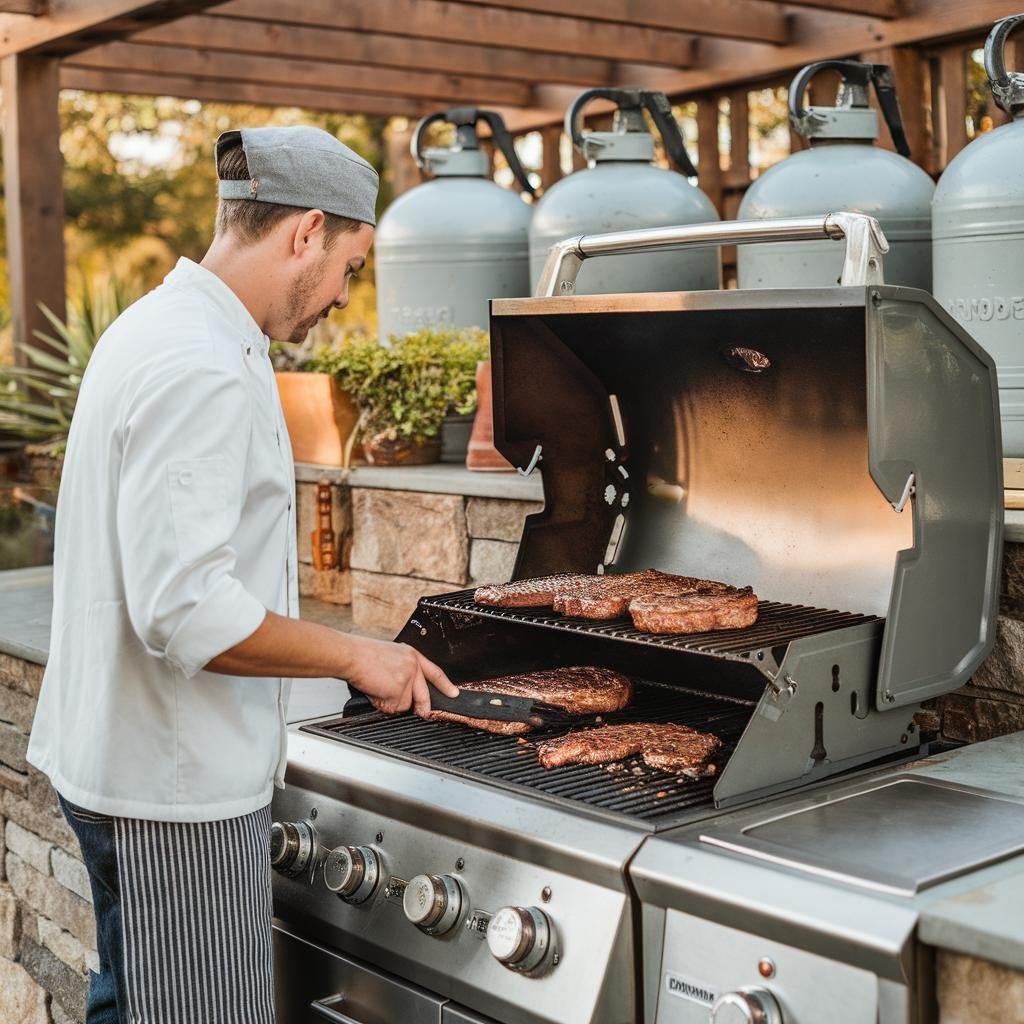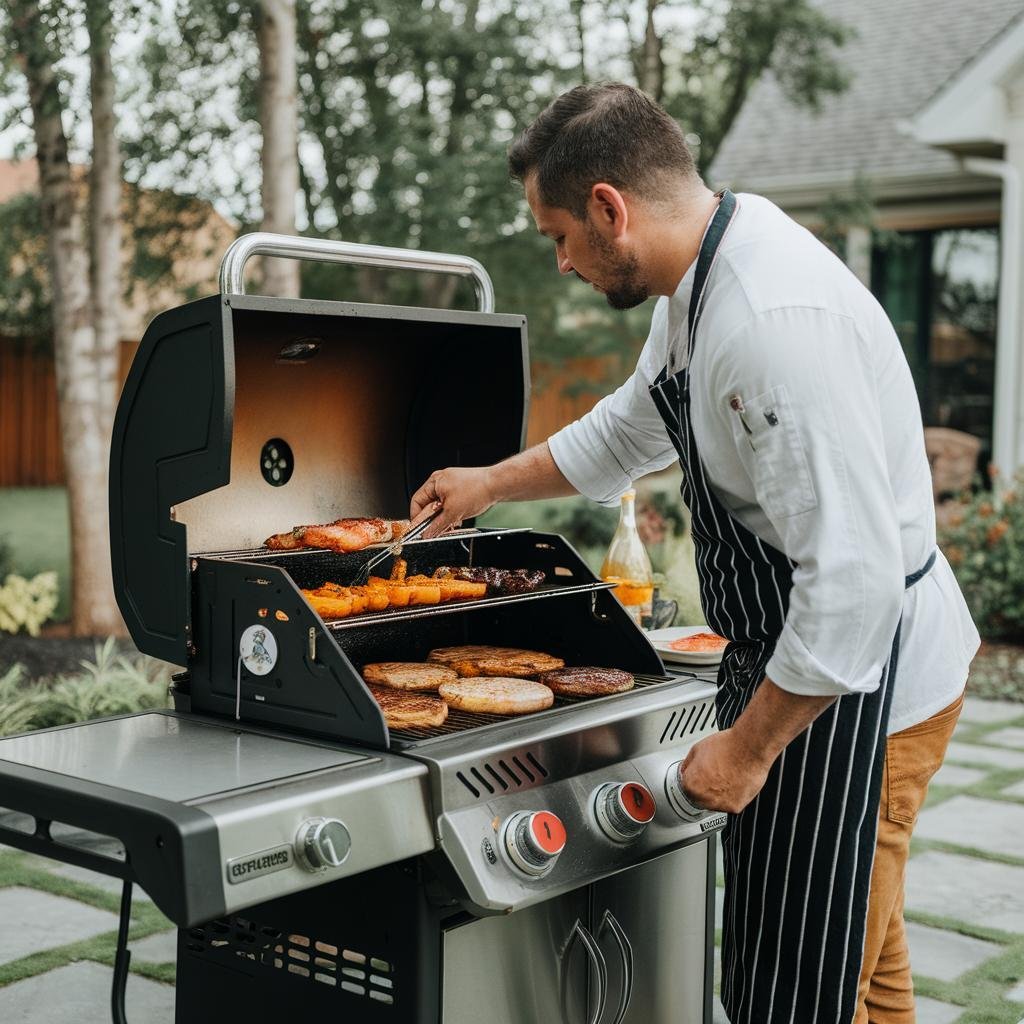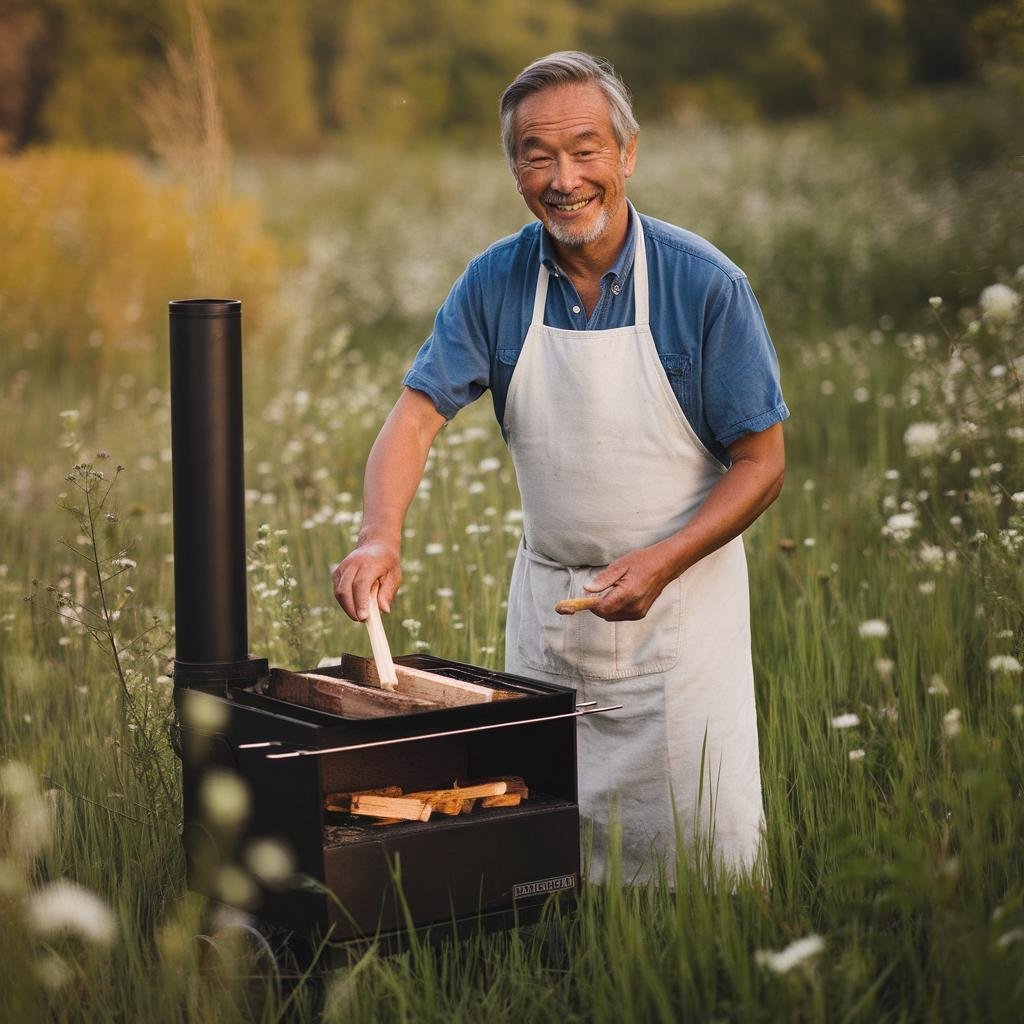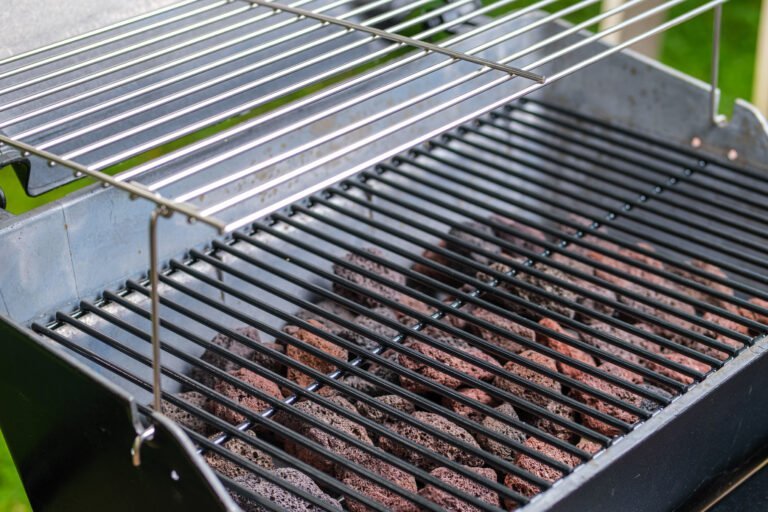Disclosure: This Post Contains Affiliate Links; We earn a commission on purchases.
Hosting a backyard BBQ needs a propane tank for your grill. Ever wondered how many BBQs you can have with one tank? Let’s explore the facts!
The amount of BBQs depends on the tank’s size. A common size is a 20 lb tank for home use. It can usually manage 10-15 cookouts. But remember, this amount might change based on how long you grill and the weather.
The grill’s efficiency also affects this. A well-kept grill uses propane well, giving you more BBQs. But if your grill is old or not efficient, it might use more propane.
Thinking of switching from charcoal to propane? Propane tanks are more convenient and last longer than charcoal. They are easy to refill or exchange. Propane grills also offer even heat and better control, making food taste great.
The number of BBQs you get from a propane tank depends on many things. Like tank size, grill efficiency, and how you grill. Knowing these can help you make the most of your tank for fun BBQ sessions!
Key Takeaways:
- The number of BBQs from a propane tank depends on factors like tank size, grill efficiency, and grilling habits.
- A 20 lb propane tank can typically accommodate 10-15 cookouts, but this may vary based on session duration and temperature.
- A well-maintained and efficient grill uses propane more efficiently, allowing for more cookouts from a single tank.
- Converting from a charcoal to a propane grill offers convenience and consistent heat control.
- Understanding propane tank factors and making informed choices can maximize grilling enjoyment.
Understanding Propane Tanks and Capacity
Propane tanks are key for BBQ fun. They hold 20 lbs of gas for your grill. But, the full amount can be a bit less in colder weather.
Every tank has a tare weight, the weight of it empty. A 20 lb tank’s tare weight is about 17 lbs. To check how much gas you have left, weigh the tank. A full tank weighs around 37 lbs.
Be very careful with propane tanks. Make sure the connections are tight and won’t leak. Propane is very flammable, so be safe. Keep tanks in a breezy spot away from fire risks.
“Safety should always be a top priority when using propane tanks for BBQ grills. Handle and store propane tanks with care to prevent accidents and ensure a safe grilling experience.”
Below is a table comparing various propane tank sizes and their gas capacities.
| Tank Size (lbs) | Propane Capacity (lbs) | Tare Weight (lbs) | Total Weight (lbs) |
|---|---|---|---|
| 20 | ~18-19 | ~16-17 | ~36-37 |
| 30 | ~27-28 | ~24-25 | ~54-55 |
| 40 | ~36-37 | ~32-33 | ~68-69 |
Measuring BBQ Usage from Propane Tank
To keep track of how much gas you use, weigh the tank when it’s full. As you cook, weigh it now and then. This tells you how much gas is left.
Different things affect how long a tank lasts, like the tank size and your grill’s efficiency. Knowing these can help you have more BBQ fun. And, don’t forget to be safe!
Factors Affecting BBQ Usage From Propane Tank
For the best BBQ grilling, certain things about your propane tank matter a lot. Knowing what these are can make your grilling time better. It helps ensure you use your BBQ the right way and enjoy the food you cook.
BBQ Grill Efficiency
Your grill’s performance is key in using propane well. A good grill uses propane in a way that lasts more cooking times. Keeping your grill clean and its parts in good shape helps a lot. Also, when cooking, keeping the lid closed boosts efficiency too.
“By properly maintaining your BBQ grill, you can optimize its efficiency, using propane more effectively for longer-lasting cookouts.” – Grill Master Magazine
Propane Tank Lifespan
How long your tank lasts matters for how many BBQs you can do. Old tanks might leak gas or work less well. You should check your tank often for any problems, like rust. If it’s really old or damaged, getting a new tank is a good idea. And, keeping your tank in a cool, dry spot can make it last longer and work better.
To see how different things affect your BBQ tank use, here’s a table:
| Factors | Effect |
|---|---|
| BBQ Grill Efficiency | Maximizes propane usage, allowing for more cookouts |
| Propane Tank Lifespan | Older tanks may have more wear and tear, leading to less efficient usage |
Comparing Refill Options for Propane Tanks
You have many choices for getting your propane tank refilled. Costco is a top pick for BBQ fans. Here, you can get a refill for only $9.99. But, they fill it to about 75% full, which is 15 lbs of propane.
If getting a full tank is more your style, there’s Blue Rhino and AmeriGas. Their refills cost more, between $16 and $20, but you get a full tank.
| Refill Option | Fill Percentage | Cost (USD) |
|---|---|---|
| Costco | 75% | $9.99 |
| Blue Rhino | 75% | $16 |
| AmeriGas | 75% | $20 |
The best choice depends on what you want. If saving money is your main goal, Costco is great. But, for those who need a full tank, Blue Rhino or AmeriGas is the way to go.
Your pick really comes down to what matters most to you. Think about how much you want to spend and what amount of propane you need. This will help you find the perfect refill option for your budget.
Safety Considerations for Propane Tanks
Safety is key when using propane tanks for BBQ grills. By knowing the dos and don’ts, you’ll avoid accidents.
Make sure the propane tank is connected right to the grill. All fittings should be tight to stop gas leaks. A secure link is key for using the tank safely.
Never forget propane is dangerous. Keep tanks in an open area, away from fire risks. This keeps the chance of fires low.
Check the tank often for any damage. If you see dents or rust, get advice. This ensures the tank stays safe.
“Propane gas is highly flammable, so it is crucial to handle and store tanks with care.”
Be careful when moving propane tanks. Keep them standing up and fixed tightly to avoid accidents. Never handle them roughly to prevent leaks.
Using the right gear is also essential. Choose hoses and regulators meant for propane use. Always follow what the grill maker says to grill safely and well.
Always be ready for the worst. Keep a fire extinguisher close by. Know how to put out a fire and what to do if you need to leave.
Keep safe to have fun grilling. Always put safety first when you use a propane tank for your BBQ.
Understanding New Safety Standards for Propane Tanks
It’s key to know about new propane tank BBQ safety. Since April 1, 2002, new rules aim to make BBQs safer. These rules stop propane leaks and fires, making grilling safer for all.
New propane tanks now have a special over-fill prevention. This stops tanks from being overfilled. It makes leaks and fires less likely. So, grilling with these new tanks is safer and people can relax.
“Safety first should be the motto of every griller. These new rules make grilling safer for users and the environment. Remember to follow the rules and use the new, safer tanks.”
Spotting the new, safe tanks is easy. Look for a valve handle with three prongs. Older tanks have handles with five prongs. These updated, safer tanks are the new standard.
To be as safe as possible, change old tanks for the new ones. This way, everyone can enjoy grilling outdoors with less worry.
Considerations for Charcoal Grills and Safety
Propane grills are the focus here. But, we must talk about charcoal grill safety. Like propane, charcoal grills need precautions for safe and fun grilling.
Carbon Monoxide Hazard
Charcoal grills produce carbon monoxide. This gas is dangerous and can kill in closed spaces. You can avoid carbon monoxide poisoning by:
- Never burn charcoal indoors or in closed spaces. They trap the gas.
- Always use your grill outside in a place with good air movement. This helps the gas move away.
Safe Usage Tips
Now, let’s look at some safe tips for using charcoal grills.
- Put the grill on a firm, non-flammable spot. Keep it away from things that can burn.
- Stay clear of things that might catch fire, like trees or furniture.
- Use long tools for safety from the fire and keep a fire extinguisher close.
- Read the manual for your grill carefully. It tells you how to safely use it.
“Charcoal grilling gives a unique taste to your food, but safety first. Knowing about carbon monoxide and using the grill right keeps you safe. You can barbecue safely and enjoy the taste.”
Visualizing Charcoal Grill Safety
Below is a table to help you understand charcoal grill safety:
| Charcoal Grill Safety Tips | Explanation |
|---|---|
| Outdoor Use Only | Never use a charcoal grill indoors to prevent carbon monoxide buildup. |
| Proper Ventilation | Ensure there is sufficient airflow around the charcoal grill to dissipate carbon monoxide. |
| Stable Placement | Set up the charcoal grill on a stable surface away from flammable materials. |
| Fire Safety | Keep a fire extinguisher nearby and follow safe grilling practices to prevent accidents. |
| Follow Instructions | Read and adhere to the manufacturer’s guidelines for assembly, lighting, and usage. |
By remembering these tips and being careful, you can safely enjoy the taste of grilled food. This way, you protect yourself and others from harm.
Conclusion
Using a propane tank for your BBQ has many things to think about. The size of the tank and how well your grill works matter. Also, how long you grill each time can affect how many BBQs you have.
It’s key to keep safe by knowing how to use propane tanks. This helps avoid accidents.
For refilling, you have different choices. You might pay less for a not full tank. Or pay a bit more for a full one. Think about your budget and how often you grill to choose the best option.
Consider these things and stay safe to enjoy your propane tank fully. No matter the event size, managing your propane use and pick the best refill option ensures nice BBQ times every time.
References


Ryan Conlon is a BBQ enthusiast and inspired chef on a journey through the smoky, savory world of outdoor cooking. Hailing from the heart of the Midwest, Ryan’s passion for grilling ignited during his early years, where family gatherings often revolved around the sizzle of the grill and the aroma of seasoned meats.






